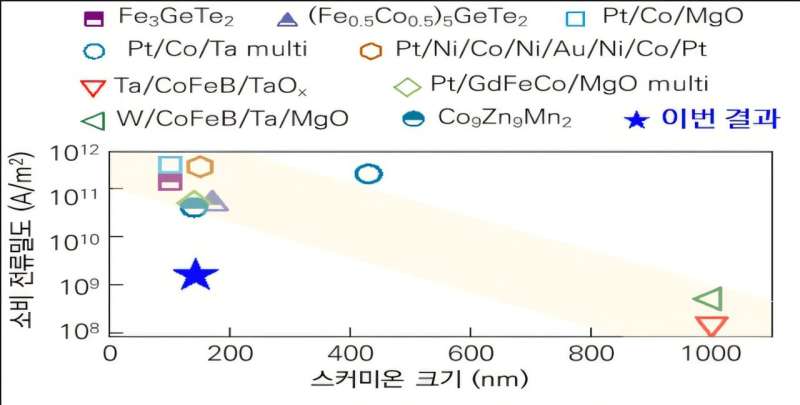The Korea Research Institute of Standards and Science (KRISS) has, for the first time in the world, generated and controlled skyrmions at room temperature in two-dimensional (2D) materials. This achievement reduces power consumption compared to traditional three-dimensional (3D) systems while maximizing quantum effects, making it a core technology for the development of room-temperature quantum computers and AI semiconductors.
The study is published in the journal Advanced Materials.
A skyrmion is a spin structure arranged in a vortex shape, theoretically reducible to just a few nanometers and capable of moving with very low power. If skyrmions could be freely created and manipulated in reality, it would enable the development of next-generation devices with ultra-low power consumption and high performance. As such, research is being actively conducted in this field.
While previous skyrmion applications have only been explored in 3D magnets, the first report of 2D magnets in 2017 broadened research to include 2D materials.
The advantage of 2D over 3D lies in a smoother surface, akin to ice, which reduces friction (heat) and noise when operating skyrmions, allowing for stable operation with lower power consumption. In addition, skyrmions in 2D are smaller than those in 3D, enhancing quantum phenomena.
KRISS succeeded in generating and controlling skyrmions in 2D magnets at room temperature. By applying a very fine voltage and magnetic field to the surface of the magnet, skyrmions were created and then driven in the desired direction with a current.

The experimental results showed that the power consumption for controlling skyrmions in 2D was approximately 1/1000 of that in 3D, and their size was reduced by more than ten-fold, providing significant advantages in terms of stability and speed. Although room-temperature skyrmion creation in 2D has been reported by the US and China at around the same time, KRISS is the first to succeed in both formation and electrical control.
This success comes about a year after the research team developed a 3D skyrmion transistor last February, advancing the development of next-generation spintronic devices. Notably, this technology maximizes the quantum effects of skyrmions at room temperature. This in turn suggested the potential for realizing room-temperature qubits using skyrmions, thereby addressing some of the limitations of existing quantum computers that operate only in ultra-low temperature environments.
Seungmo Yang, the Senior Research Scientist from the KRISS Quantum Magnetic Sensing Group said, “With the recent advances in AI, the demand for ultra-low power semiconductor devices is increasing. Our skyrmion control technology can contribute to the design of next-generation AI semiconductor devices.”
More information:
Yubin Ji et al, Direct Observation of Room‐Temperature Magnetic Skyrmion Motion Driven by Ultra‐Low Current Density in Van Der Waals Ferromagnets, Advanced Materials (2024). DOI: 10.1002/adma.202312013
Citation:
Controlling skyrmions at room-temperature in 2D topological spin structure technology (2024, November 6)
retrieved 6 November 2024
from
This document is subject to copyright. Apart from any fair dealing for the purpose of private study or research, no
part may be reproduced without the written permission. The content is provided for information purposes only.

